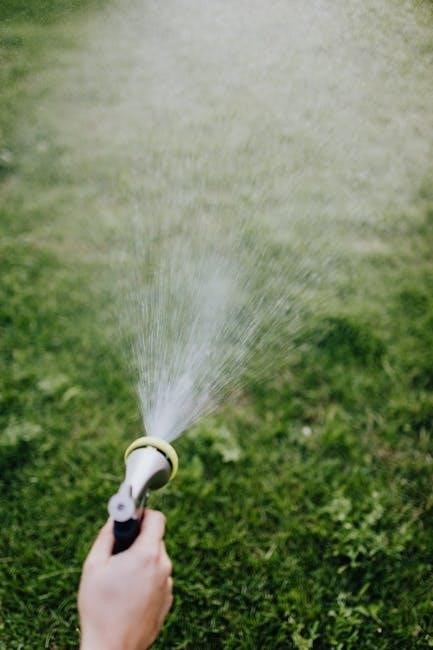Water softener regeneration is necessary to remove minerals,
introduction
explains the process, and it involves manual or automatic methods to restore softener functionality, using a knob or button to initiate the process, typically.
Understanding the Importance of Regeneration
Regeneration is a crucial process for water softeners as it enables them to continue removing minerals from hard water. Without regeneration, the softener’s resin becomes exhausted, leading to reduced efficiency and potentially causing damage to the system. The importance of regeneration lies in its ability to restore the softener’s capacity to remove minerals, ensuring that water remains soft and safe for use. Regular regeneration also helps to prevent the buildup of minerals in the system, which can lead to scaling and corrosion. By understanding the importance of regeneration, users can take steps to ensure their water softener operates effectively and efficiently. This involves initiating the regeneration process at the right time, whether manually or automatically, to maintain optimal performance. Proper regeneration is essential for extending the lifespan of the water softener and ensuring it continues to provide soft water for household use. Effective regeneration also helps to reduce maintenance costs and minimize the risk of system failure.

Types of Water Softener Regeneration
Manual and automatic regeneration types are available, allowing users to choose the method that suits their needs, with manual requiring a knob or button to initiate the process, typically.
Manual Regeneration Process
The manual regeneration process involves a series of steps that allow users to initiate the regeneration cycle, typically by turning a knob or pressing a button on the water softener. This process is usually done when the water softener is not equipped with an automatic regeneration feature. The user must first ensure that the water softener is in the correct mode, usually by checking the control panel or settings. Once the correct mode is selected, the user can initiate the regeneration cycle, which will start the process of flushing out the minerals and replenishing the resin. It is essential to follow the manufacturer’s instructions for manual regeneration, as the steps may vary depending on the specific model and type of water softener. By following the correct procedure, users can ensure that their water softener is functioning correctly and providing soft water to their household. Regular manual regeneration can help maintain the water softener’s efficiency and prolong its lifespan.
The Five Stages of Water Softener Regeneration
Regeneration occurs in multiple stages, including backwashing, to restore water softener functionality and efficiency properly.
Stage 1: Brine Tank Fill
The initial stage of water softener regeneration involves filling the brine tank with water, which is a crucial step in the process. This stage is necessary to create a brine solution, a mixture of water and salt, that will be used to recharge the resin beads in the water softener. The water level in the brine tank should be below the salt level to ensure proper mixing and to prevent overflow. It is essential to check the brine tank regularly to ensure it has enough salt to create the brine solution, as this will affect the overall efficiency of the water softener. The brine tank fill stage is typically followed by other stages, including backwashing and rinsing, to complete the regeneration process. By understanding this stage, users can better maintain their water softener and ensure it continues to function properly. Regular checks and maintenance can help prevent issues and extend the lifespan of the water softener.

Automatic Regeneration
Modern water softeners often feature automatic regeneration, using a timed schedule to initiate the process, typically at early morning hours, roughly once per week, for optimal efficiency and convenience always.
Timed Schedule Regeneration
Timed schedule regeneration is a feature found in many modern water softeners, allowing for automatic regeneration at set intervals, typically once a week, during early morning hours when water usage is low. This feature ensures that the water softener is always functioning at optimal levels, providing soft water to the household. The timed schedule regeneration process is usually controlled by a module that can be adjusted to suit the specific needs of the household. By having a regular regeneration schedule, the water softener can maintain its effectiveness in removing minerals and other impurities from the water, providing a consistent supply of soft water. The use of a timed schedule also helps to reduce the risk of manual errors and ensures that the regeneration process is carried out regularly, which is essential for maintaining the water softener’s efficiency and prolonging its lifespan. Regular regeneration is crucial for optimal performance.

Benefits of Regular Regeneration
Regular regeneration reduces utility bills and maintains efficiency, ensuring optimal water softener performance always, with proper maintenance and care, using manual or automatic methods, for better results and longer lifespan.
Reducing Utility Bills and Maintaining Efficiency
Regular water softener regeneration is crucial for reducing utility bills and maintaining efficiency. By regenerating the softener, you can ensure that it continues to remove minerals and other impurities from the water, which can help to reduce energy consumption and lower your utility bills. Additionally, regular regeneration can help to maintain the efficiency of the softener, ensuring that it continues to produce soft water and preventing the buildup of scale and other deposits. This can help to extend the lifespan of the softener and reduce the need for repairs and maintenance. Furthermore, regular regeneration can also help to improve the overall performance of the softener, ensuring that it continues to provide soft water and preventing the occurrence of problems such as clogged pipes and appliances. Overall, regular regeneration is an essential part of maintaining a water softener and ensuring that it continues to function efficiently and effectively.
